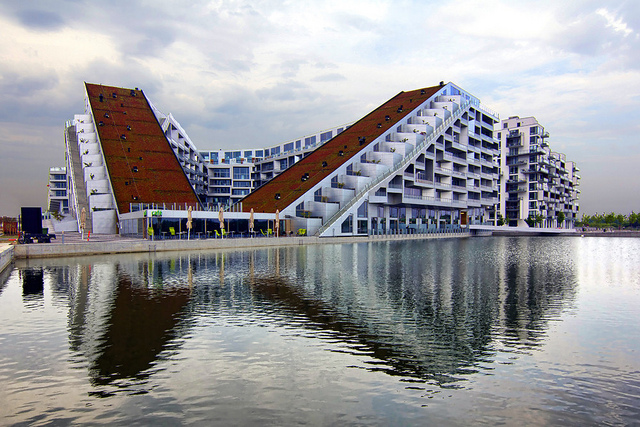What drives the 'starchitect' Bjarke Ingels?

 Architecture is a game of persistence. It can take years, or even decades, to build a career, a name, a practice...and to build actual buildings, of course. Here's some evidence: architecture's highest award, the Pritzker Prize, has never gone to anyone in their 40s--and most winners are way above 50 years old, as The New Yorker's Ian Parker recently observed. So the success and global name recognition of 37-year-old Danish architect Bjarke Ingels (whose work we discuss regularly on SmartPlanet) is an anomaly of sorts. Achingly hip and astonishingly fresh-faced, he's nearly young enough to be Frank Gehry's grandson.
Architecture is a game of persistence. It can take years, or even decades, to build a career, a name, a practice...and to build actual buildings, of course. Here's some evidence: architecture's highest award, the Pritzker Prize, has never gone to anyone in their 40s--and most winners are way above 50 years old, as The New Yorker's Ian Parker recently observed. So the success and global name recognition of 37-year-old Danish architect Bjarke Ingels (whose work we discuss regularly on SmartPlanet) is an anomaly of sorts. Achingly hip and astonishingly fresh-faced, he's nearly young enough to be Frank Gehry's grandson.
Many thirtysomething designers are still paying their dues at his stage in life. But Ingels (and his firm, BIG, which is a grand acronym for Bjarke Ingels Group) is often featured in major, mainstream publications such as Time magazine. He has a high-profile Manhattan building in the works. And has already taught at no less than Yale.
What makes this boy-wonder, known for such original, playful concepts such as a waste-treatment plant with a ski-slope on its roof, tick creatively? What can design-conscious executives of any generation learn from his style of design strategy?
A long and detailed profile in the September 10 issue of The New Yorker (available online to subscribers or for a fee) looks at Ingels's attitudes and approaches toward architecture, design, and innovation. These include:
- "Confident reimaginings," as author Ian Parker describes Ingels' work, of existing forms. In other words, Ingels doesn't reinvent the proverbial wheel entirely, but plays with it. While other architects may attempt to create blob-like, computer-graphics-inspired buildings that defy the classic linearity of most edifices, he rearranges shapes and structures that might seem familiar, only tweaked.
- "You can have high competence, ambition, without having stress and fear as the motivating factor," Ingels told The New Yorker. "You can be critical through affirmation rather than negation. You can be critical by putting forward alternatives rather than spending all your energy whining about the alternatives you don't like." In other words, he manages people and projects by focusing on the positive and by posing solutions rather than tearing down ideas that don't work.
- He relies on "concise, relaxed storytelling" (as Parker wrote) to describe his projects to colleagues, the media, real estate developers, students, and clients alike. That said, Ingels also experiments with new ways of narratives to show off his ideas, from a YouTube video of himself riding a bike through a building he designed, to writing a novel. The New Yorker story mentions he is planning to pen a conspiracy thriller on the deaths of famous architects, ending with a fight scene on top of his newest--and real--building, called W57, in Manhattan.
- Constraints, or at least very specific client guidelines, seem to lead to BIG's most creative work, according to Parker's opinion, at least. This may seem counter-intuitive to some innovation-minded designers. Ingels seems to benefit from working within the challenges of boundaries, or client wishes.
- Ingels and his colleagues focus on what they call "hedonistic sustainability." The idea is to design for the benefit of the environment while also designing fun environments for humans to enjoy. Hence placing a ski slope atop a waste incinerator--a project in Denmark that was stalled earlier this year, as we reported, but just this week has been revived.

- Ingels may not be understood as an old-school architect, but a new-school type of designer who works very quickly, at the pace of say interaction or website design, according to New Yorker interviewee Philip Ryan, a peer of Ingels who works at the architecture firm of Tod Williams and Billie Tsien. "Whether he can be compared to Herzog and de Meuron or Zaha Hadid is almost irrelevant," Ryan said, referencing some of the world's most revered current architects. "He needs to be compared to Apple."
- Ingels seems to turn to dreams and fantasy and marries them with a pragmatic frame of mind. "What architects should do is make the world a little bit more like our dreams, in a very practical way," he said. Kind of like the idea of an incinerator with a ski slope on top.
Images: Photo of Ingels, Paul Wilkinson/Flickr; images of Copenhagen buildings by BIG, Wojtek Gurak/Flickr
Related on SmartPlanet:
What real estate developers should learn from architects
BIG wins Kimball Art Center redesign competition by unanimous vote
High-profile Copenhagen energy plant with ski slope roof denied funding
This post was originally published on Smartplanet.com